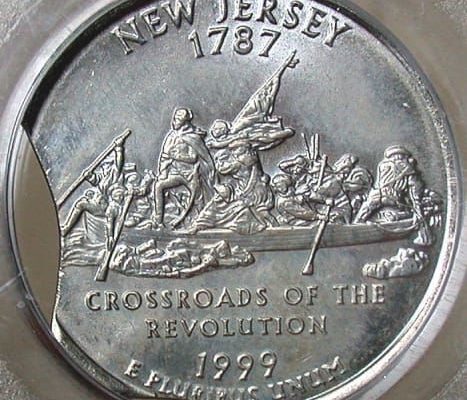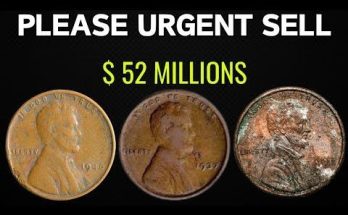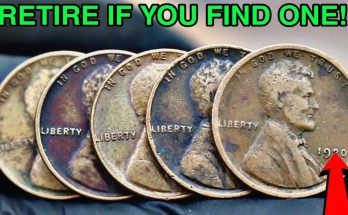Can you spot the error on this Wisconsin state quarter?
coinpage.com
Value of State Quarters
There’s no doubt about it: the statehood quarter program was the most publicized coin mintage of the 21st century. I’m sure that many of us can still remember watching commercials for the quarter program many years after its inception. With so much exposure, it shouldn’t come as a surprise to hear that these quarters were the most collected mintage in United States history. In total, a dazzling 56 designs were produced in a record-breaking 10-year period.
It was a truly amazing feat, but since they were produced in such vast quantities, the majority of these coins retain very little value. Unless, that is, you possess an error quarter! Although uncommon, misprinted statehood quarters are very real, and so is their increased value! This article will outline the history of the statehood quarter program and list some well-known and valuable errors.

Minting errors on some 2005 Kansas coins make the customary message “In God We Trust” appear to read “In God We Rust.”
State Quarter History
Here’s a bit of history and background on the statehood quarter program.
The Order of Releases
In 1999, the United States Mint began production of the 50 state quarters. Every year, five special-edition quarters would be released, each with an obverse representing a state, until a quarter had been minted for every state. These limited-edition coins were released into circulation in the same order the states came into statehood.
Changes on the Obverse and Reverse
Washington’s portrait is still on the obverse of the state quarters, but some changes were made. The word “Liberty” was printed smaller, and the phrase “United States Quarter Dollar” was moved from the reverse to the obverse of the coin.
The reverse sides of the state quarters feature the year minted and one of the 50 unique state designs. The designs found on these quarters were chosen by the state governor and will never be reproduced again.
Extension: Which District and Territories Also Have Quarters?
The United States began minting an extension of the original 50 states quarter program in 2009. These additional quarters commemorated:
- The District of Columbia
- Puerto Rico
- American Samoa
- Guam
- The United States Virgin Islands
- The Northern Mariana Islands
State Quarter Releases by Year
- 1999: Delaware, Pennsylvania, New Jersey, Georgia, Connecticut
- 2000: Massachusetts, Maryland, South Carolina, New Hampshire, Virginia
- 2001: New York, North Carolina, Rhode Island, Vermont, Kentucky
- 2002: Tennessee, Ohio, Louisiana, Indiana, Mississippi
- 2003: Illinois, Alabama, Maine, Missouri, Arkansas
- 2004: Michigan, Florida, Texas, Iowa, Wisconsin
- 2005: California, Minnesota, Oregon, Kansas, West Virginia
- 2006: Nevada, Nebraska, Colorado, North Dakota, South Dakota
- 2007: Montana, Washington, Idaho, Wyoming, Utah
- 2008: Oklahoma, New Mexico, Arizona, Alaska, Hawaii
- 2009: District of Columbia, Puerto Rico, American Samoa, United States Virgin Islands, Northern Mariana Islands
State Quarter Mistakes
These 56 quarters are a great way to snag a piece of American history and appeal to beginners and experienced coin collectors alike. But, as mentioned earlier, there isn’t a whole lot of value currently contained in regular mintage state quarters. Between 400,000,000 and 1,600,000,000 copies of each were minted.
Unlike the regular minted coins, those with errors are far fewer in number and have a huge demand. With that demand, values for these coins can sometimes reach up to several hundred dollars. Below is a list of the most common error coins from the collection, as well as approximate values for these rare state quarters.
1999 Delaware Spitting Horse Error
Die cracking at the Philadelphia mint led to some quarters with extra metal around the horse’s mouth. This extra metal looks as if the horse is spitting. Depending on the progression of the die crack and the condition of the coin, these errors can bring in anywhere from $2 to $20.
2004 Wisconsin Leaf Errors
Coins exhibiting these errors came from the Denver Mint. These coins can fetch $50 to $100 each.




2005 Minnesota Double Die and Extra Tree Errors
There are a lot of errors associated with the Minnesota reverse. Values range from $10 to $300+.
2005 Kansas “IN GOD WE RUST” and Humpback Bison Errors
Values really vary with these errors, but sometimes they can reach up to $100.
2006 Colorado Cud Errors
Cud errors (an unintentional bump caused by a dent in the die) on the reverse side of the quarter can be viewed at the three o’clock position along the inner side of the rim. These quarters were released by the Philadelphia Mint. Depending on the size of the cud, these quarters can fetch a value of $5 to $35.
2007 Wyoming Double Die Reverse
This lesser-known error was minted in Philadelphia and sometimes can be hard to spot with the naked eye. With magnification, varied doubling around the saddle horn can be seen. Values for this error are unknown.
2008 Arizona Extra Cactus Leaves
Die breaks caused extra leaves on the Arizona Reverse. Values vary, but coins are generally sold for around $10 to $20.
2009 District of Columbia Double Die Reverse
Some quarters minted in Denver exhibit doubling on the “ELL” in “ELLINGTON.” With this variety, a greater degree of doubling translates into higher demand, but the market for this coin is still too young to solidify any general value.
State Quarters on Nickel Planchets
These odd coins can show up in any year, but they seem to be more common in the first year Delaware, Connecticut, New Jersey, Pennsylvania, and Georgia coins. Accidentally struck on nickel planchets, these coins are slightly smaller than a regular quarter. The error coin diameter size is 21.2 millimeters; a regular quarter size is 24.3 millimeters. Values for these coins depend on condition, but they can reach well over $1,000.
Other Errors
There are many different errors that have shown up in almost every year of mintage. Some of these errors may include die breaks, off-center striking, planchet clipping, die cuds, grease strike-through errors, and missing layers. As the market is still fairly young, values for these types of errors will vary greatly, but they could be worth $5 to $300+, depending on what you have.
Check out some more examples of coins with errors below!






Good Luck!
State quarter errors are by far the most valued quarters of the statehood collection, but they’re also much harder to find. Don’t let the odds overcome you, though! With billions of these quarters minted, there’s always a chance one of these valuable errors will find its way into your pocket change! Keep a sharp eye out, and never give up on searching. You could have a valuable state quarter error sitting around right now, but if you never look, you’ll never know!
As always, thank you for reading this article on state quarter errors, and good luck with your coin-collecting endeavors!
More on American Coinage
If you’ve enjoyed this article and want more information about American coinage, be sure to check out my other articles:





